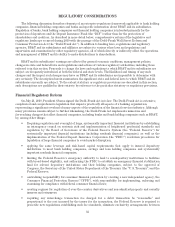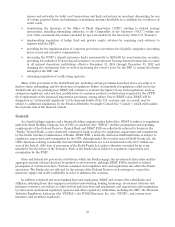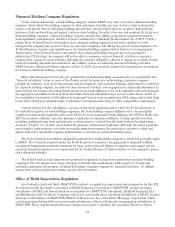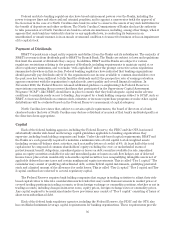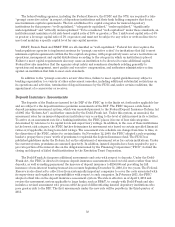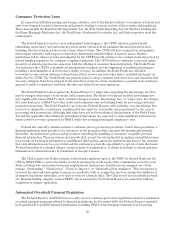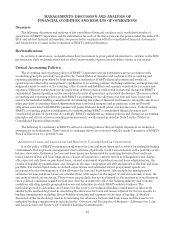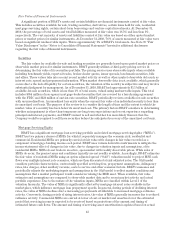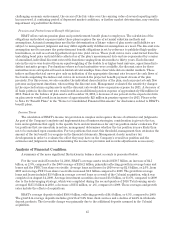BB&T 2010 Annual Report Download - page 36
Download and view the complete annual report
Please find page 36 of the 2010 BB&T annual report below. You can navigate through the pages in the report by either clicking on the pages listed below, or by using the keyword search tool below to find specific information within the annual report.Federal and state banking regulators also have broad enforcement powers over the Banks, including the
power to impose fines and other civil and criminal penalties, and to appoint a conservator (with the approval of
the Governor in the case of a North Carolina state bank) in order to conserve the assets of any such institution for
the benefit of depositors and other creditors. The North Carolina Commissioner of Banks also has the authority
to take possession of a North Carolina state bank in certain circumstances, including, among other things, when it
appears that such bank has violated its charter or any applicable laws, is conducting its business in an
unauthorized or unsafe manner, is in an unsafe or unsound condition to transact its business or has an impairment
of its capital stock.
Payment of Dividends
BB&T Corporation is a legal entity separate and distinct from the Banks and its subsidiaries. The majority of
BB&T’s revenue is from dividends paid to BB&T by Branch Bank. The Banks are subject to laws and regulations
that limit the amount of dividends they can pay. In addition, BB&T and the Banks are subject to various
regulatory restrictions relating to the payment of dividends, including requirements to maintain capital at or
above regulatory minimums, and to remain “well-capitalized” under the prompt corrective action regulations
summarized elsewhere in this section. Federal banking regulators have indicated that banking organizations
should generally pay dividends only if (1) the organization’s net income available to common shareholders over
the past year has been sufficient to fully fund the dividends and (2) the prospective rate of earnings retention
appears consistent with the organization’s capital needs, asset quality and overall financial condition. In
November 2010, the Federal Reserve released additional guidance re-emphasizing the Federal Reserve’s
expectations concerning the processes that firms that participated in the Supervisory Capital Assessment
Program (“SCAP”), like BB&T, should have in place to ensure that they hold adequate capital under adverse
conditions to maintain ready access to funding. Any request by a bank holding company subject to SCAP, such as
BB&T, to increase dividends on common stock, reinstate or increase repurchase programs or make other capital
distributions will be evaluated based on the Federal Reserve’s assessment of capital adequacy.
North Carolina law states that, subject to certain capital requirements, the board of directors of a bank
chartered under the laws of North Carolina may declare a dividend of as much of that bank’s undivided profits as
the directors deem appropriate.
Capital
Each of the federal banking agencies, including the Federal Reserve, the FDIC and the OTS, has issued
substantially similar risk-based and leverage capital guidelines applicable to banking organizations they
supervise, including bank holding companies and banks. Under the risk-based capital requirements, BB&T and
the Banks are each generally required to maintain a minimum ratio of total capital to risk-weighted assets
(including certain off-balance sheet activities, such as standby letters of credit) of 8%. At least half of the total
capital must be composed of common shareholders’ equity excluding the over- or underfunded status of
postretirement benefit obligations, unrealized gains or losses on debt securities available for sale, unrealized
gains on equity securities available for sale and unrealized gains or losses on cash flow hedges, net of deferred
income taxes; plus certain mandatorily redeemable capital securities; less nonqualifying intangible assets net of
applicable deferred income taxes and certain nonfinancial equity investments. This is called “Tier 1 capital.” The
remainder may consist of qualifying subordinated debt, certain hybrid capital instruments, qualifying preferred
stock and a limited amount of the allowance for credit losses. This is called “Tier 2 capital.” Tier 1 capital and Tier
2 capital combined are referred to as total regulatory capital.
The Federal Reserve requires bank holding companies that engage in trading activities to adjust their risk-
based capital ratios to take into consideration market risks that may result from movements in market prices of
covered trading positions in trading accounts, or from foreign exchange or commodity positions, whether or not in
trading accounts, including changes in interest rates, equity prices, foreign exchange rates or commodity prices.
Any capital required to be maintained under these provisions may consist of “Tier 3 capital” consisting of forms of
short-term subordinated debt.
Each of the federal bank regulatory agencies, including the Federal Reserve, the FDIC and the OTS, also
has established minimum leverage capital requirements for banking organizations. These requirements provide
36








